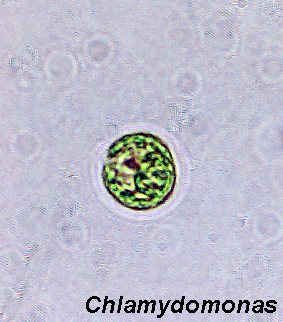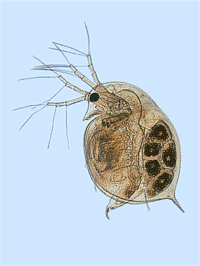
This lesson explores some of the relationships between algae and daphnia.
Algae and daphnia live in ponds and puddles. Algae have chlorophyll. That helps them make sugar. It also makes the water green. Algae are small. You need a microscope to see them.
 | |
Like plants, algae need light and nutrients to grow. The nutrients are dissolved nitrogen in the form of nitrates, other minerals and CO2. The nutrients come from bacteria that break down plant and animal wastes. If the water has a lot of nutrients the algae can grow quickly, doubling in number every day. As they consume the nutrients their growth slows.
You can grow algae yourself. Put an aquarium near a window where sunlight will strike it. Remember that algae like plants need light as well as nutrients to grow. Supply the nutrients with dirty water from a fish tank. Every week when you do a water change in the fish tank put some of it in the algae tank. In a few weeks the algae will grow and turn the water green.
The algae get energy from sunlight. If the pond isn't under trees it gets plenty of sun in the summer. In the winter there is less sun so the algae grow slower.
1. When the water is dark green will all of the algae receive the same amount of light?
Temperature also affects algae growth. As the water temperature falls below 70 degrees algae grow slower. As the temperature approaches freezing algae stops growing.
The algae will start to die if the water is too dark or they run out of nutrients. Then the bacteria will break down the dead algae producing CO2 and nutrients. If there are enough bacteria they can use up most of the oxygen in the water. Fish also need oxygen. Some times this lack of oxygen kills large numbers of fish.
Daphnia eat algae and bacteria. Daphnia are small but you can see them with your unaided eye.
 |
 |
Adult daphnia are about the size of sesame seeds. The circles on the daphnia's back are baby daphnia. In the summer all of the daphnia are females. They reproduce asexually by cloning themselves. In the fall when conditions aren't favorable some males are born. These males and females produce eggs. The eggs hatch in the spring.
Daphnia are crustaceans like crabs and shrimp. Crustaceans don't have bones. They have a hard exoskeleton like a shell. When daphnia grow they become too large for their exoskeletons. Then they discard their old exoskeletons and grow a new one. This process is called molting.
Every 2 days adult daphnia molt. When they molt the baby daphnia are born. When daphnia are born they are very small. The juveniles grow for about 8 days.
After 8 days of rapid growth daphnia start to reproduce. When the daphnia starts to reproduce almost 70% of its energy goes into making more daphnia. If all conditions are perfect, daphnia live approximately 50 days. If there isn't enough food the daphnia don't live as long.
